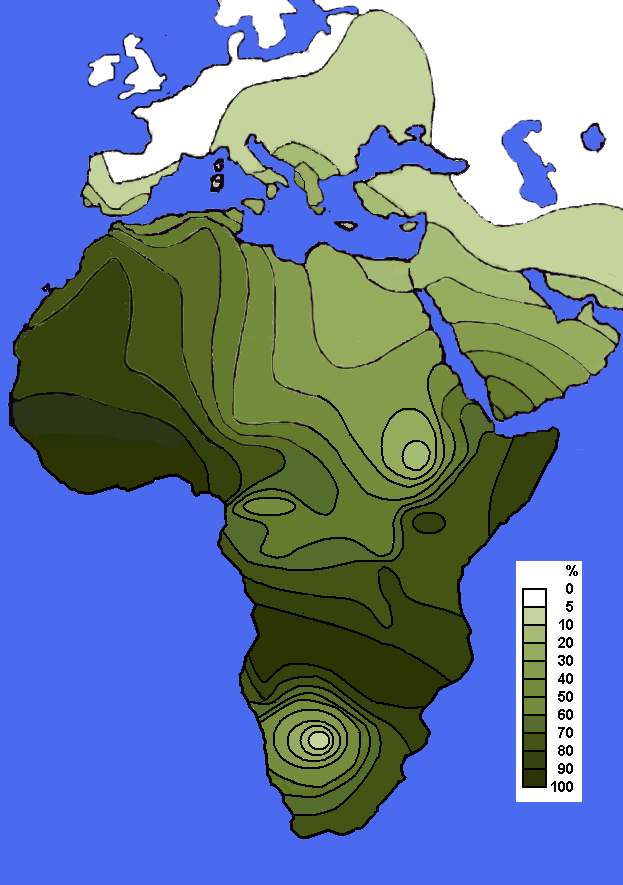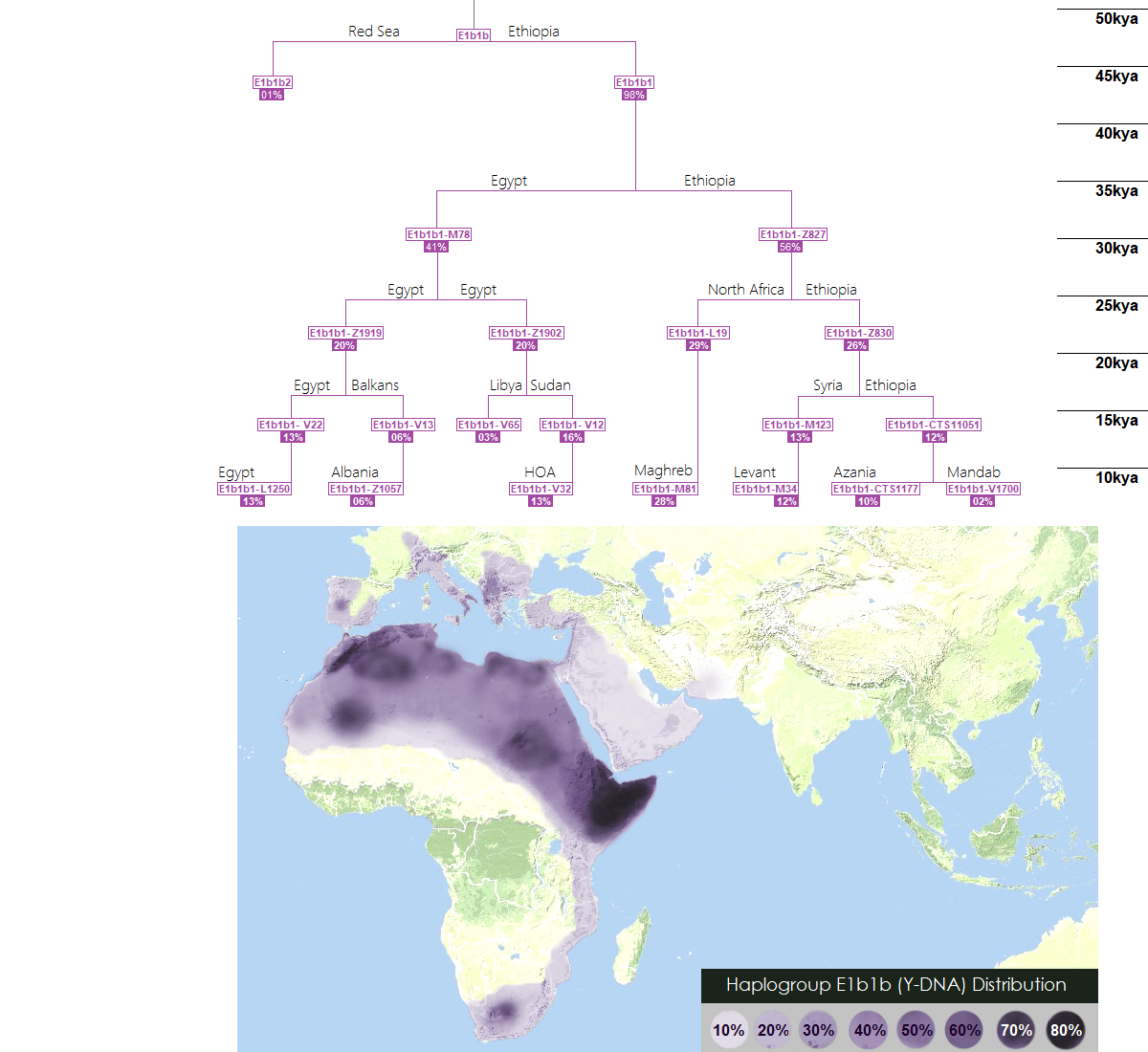|
|
Post by Διαμονδ on Nov 23, 2017 12:09:45 GMT
E-M215, also known as E1b1b and formerly E3b, is a major human Y-chromosome DNA haplogroup. It is a division of the macro-haplogroup E-M96, which is defined by the single-nucleotide polymorphism (SNP) mutation M215. In other words, it is one of the major patrilineages of humanity, linking from father-to-son back to a common male-line ancestor ("Y-chromosomal Adam"). It is a subject of discussion and study in genetics as well as genetic genealogy, archaeology, and historical linguistics. The E-M215 haplogroup has two ancient branches that contain all the known modern E-M215, E-M35 and E-M281 subclades. Of the latter two subhaplogroups, the only branch that has been confirmed in a native population outside of Ethiopia is E-M35. E-M35 in turn has two known branches, E-V68 and E-Z827, which contain by far the majority of all modern E-M215 subclade bearers. E-V68 and E-V257 have been found at highest frequencies in North Africa and the Horn of Africa, but also at lower percentages in parts of the Middle East and Europe, and in isolated populations of Southern Africa.  Distribution of haplogroup E1b1b in Europe, the Near East and North Africa Distribution of haplogroup E1b1b in Europe, the Near East and North Africa OriginsRed Sea origins & Neolithic expansion OriginsRed Sea origins & Neolithic expansionHaplogroup E1b1b (formerly known as E3b) represents the last major direct migration from Africa into Europe. It is believed to have first appeared in the Horn of Africa approximately 26,000 years ago and dispersed to North Africa and the Near East during the late Paleolithic and Mesolithic periods. E-M78 and E-Z827 originated respectively at 20,000 years and 24,000 years. E1b1b lineages are closely linked to the diffusion of Afroasiatic languages. Lazaridis et al. (2016) tested the first ancient DNA samples from the Mesolithic Natufian culture in Israel, possibly the world's oldest sedentary community, and found that the male individuals belonged either to haplogroups CT or E1b1 (including two E1b1b1b2 samples). These are to date the oldest known E1b1b individuals. The same haplogroups show up in Pre-Pottery Neolithic B Jordan, accompanied by new haplogroups (H2 and T). Besides, E1b1b was not found in Neolithic Iran or Anatolia, and only showed up twice among the hundreds of Neolithic European samples that have been tested. This evidence suggests that at the end of the last glaciation 12,000 years ago, E1b1b men were present in the Levant, but not in other parts of the Near East. There is evidence that the Natufians already cultivated cereals like rye before the Neolithic period. Cereal farming may therefore trace its roots (literally) to the E1b1b tribes of the Mesolithic Levant. Nowadays, the highest genetic diversity of haplogroup E1b1b is observed in Northeast Africa, especially in Ethiopia and Somalia, which also have the monopoly of older and rarer branches like M281, V6 or V92. This suggests that E1b1b may indeed have appeared in East Africa, then expanded north until the Levant. Nevertheless, many lineages now found among the Ethiopians and Somalians appear to have come from the Fertile Crescent during the Neolithic period. This includes some E1b1b subclades like V22 (12,000 years old) and V32 (10,000 years old), but also undeniably Near Eastern lineages like T1a-CTS2214 and J1-L136. North African Neolithic cattle herder hypothesis Decker et al (2013) reported that Iberian and Italian cattle possess introgression from African taurine, which could imply that cattle were not just domesticated in West Asia, but also independently in North Africa. If that is the case, E-M78 or E-M123 could have come to southern Europe through North African cattle herders during the Neolithic, although this hypothesis remains purely conjectural. See also : Southern Neolithic route brought Megaliths from the Levant to Western Europe. |
|
|
|
Post by Διαμονδ on Nov 24, 2017 9:29:04 GMT
The European branch of this haplogroup is E1b1b1a1a1a (V13).It refers to the ancient non-Indo-European population of Europe from the Balkans! (Balkan Neolithic)  |
|
|
|
Post by Διαμονδ on Nov 24, 2017 9:36:33 GMT
The share of E-V13 E-M35 (%) in some modern populations according to different authors:
Kosovo Albanian — 44 %,
Achaean Greeks — 44 % *
Magnetiska the Greeks — 40 % *
Carpatho-Rusyns — 32-33 %
Argive Greeks — 35 % *
Roma of the Republic of Macedonia — 30 %
the Greeks Epirus — 29 % *
Macedonians-Slavs — 22 %
Serbs 19 %
Macedonian Greeks 19-24 % *
Bulgaria — 16 %
the Italians of Apulia — 12 %
Turkish Cypriots- 11 %
the Arabs-the Druze of Northern Israel — 11 %
Under the icon * indicate the number of E1b1b1-M35 as a whole, without regard to subclades, without icon — share only E1b1b1а2-V13. It is known that in populations of South-Eastern Europe, including Greeks and Albanians, share E1b1b1а2-V13 is at least 85 % — 90 % of E1b1b1-M35.
|
|
|
|
Post by Διαμονδ on Nov 24, 2017 9:38:15 GMT
Also known as haplogroup Hitler!  |
|
|
Deleted
Deleted Member
|
Post by Deleted on Nov 24, 2017 9:43:13 GMT
Also known as haplogroup Hitler!   |
|
|
|
Post by Elizabeth on Nov 24, 2017 10:12:22 GMT
Loki...and highest are Albanians who share it?...rofl
|
|
|
|
Post by Διαμονδ on Nov 24, 2017 11:56:12 GMT
Loki...and highest are Albanians who share it?...rofl We know that there is no bad haplogroup! There are bad people everywhere! But Yes, Loki from and Albanians are related by the male line. Perhaps that is why they have such sympathy!  |
|
|
|
Post by Διαμονδ on Nov 24, 2017 23:55:28 GMT
This group is considered very offensive! Many people do not want it! All because of the many bad characters associated with this group! But each haplo unique in my opinion!
|
|
|
|
Post by Διαμονδ on Nov 30, 2017 10:26:02 GMT
|
|
kriptc06
New Member

Posts: 44 
Likes: 31
Y-DNA: E-V13
mtDNA: D
|
Post by kriptc06 on Jan 28, 2018 1:39:32 GMT
E1b1b map  |
|
|
|
Post by Διαμονδ on Jan 28, 2018 1:47:07 GMT
From what region are your roots? |
|
kriptc06
New Member

Posts: 44 
Likes: 31
Y-DNA: E-V13
mtDNA: D
|
Post by kriptc06 on Jan 28, 2018 1:48:05 GMT
From what region are your roots? My E-V13 you mean? I have no idea  |
|
|
|
Post by Διαμονδ on Jan 28, 2018 1:54:16 GMT
And presumably?  |
|
kriptc06
New Member

Posts: 44 
Likes: 31
Y-DNA: E-V13
mtDNA: D
|
Post by kriptc06 on Jan 28, 2018 1:56:08 GMT
And presumably?  Either Iberia or Balkans, I bought a V13 pack, I hope to find this out. |
|
|
|
Post by randomserb on Feb 2, 2018 15:10:29 GMT
Serbs have less then 19%. Although maybe few regions probably can rach that number, for the most tested parts it is between 11% and 15%.
It seems that Kosovo Albanians does not have as much either. Newer results show increased J and lowered E, from what I saw.
Bulgarians only 16% ?
Where did tou get this data? It is the most common single haplogroup on Bugaria, reaching over 30% by all researches I saw.
Maybe you should add sources for data.
Anyway, hello to everyone since I am new here.
|
|